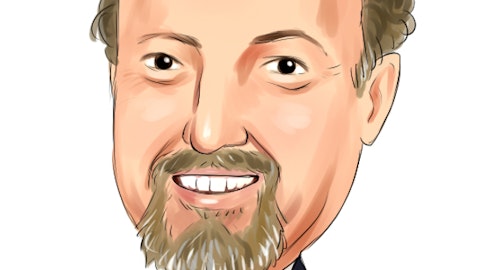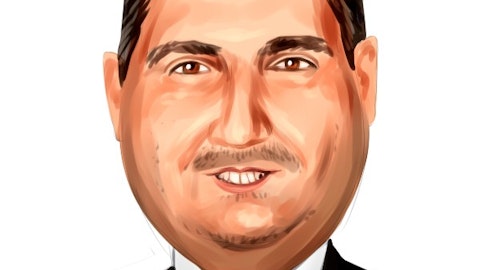Flex Ltd. (NASDAQ:FLEX) Q3 2023 Earnings Call Transcript January 25, 2023
Operator: Good afternoon, and thank you for standing by. Welcome to Flex’s Fiscal Third Quarter 2023 Earnings Conference Call. Presently, all participants are in a listen-only mode. After the speakers’ remarks, there will be a question-and-answer session. As a reminder, this call is being recorded. I will now begin, and turn the call over to Mr. David Rubin. You may begin.
David Rubin: Thank you, JP. Good afternoon, and welcome to Flex’s third quarter fiscal 2023 earnings conference call. With me today is our Chief Executive Officer, Revathi Advaithi; and our Chief Financial Officer, Paul Lundstrom. Both will give brief remarks followed by Q&A. Slides for today’s call as well as a copy of the earnings press release and summary financials are available in the Investor Relations section at flex.com. This call is being recorded and will be available for replay on our corporate website. As a reminder, today’s call contains forward-looking statements, which are based on our current expectations and assumptions. These statements involve risks and uncertainties that could cause actual results to differ materially.
For a full discussion of these risks and uncertainties, please see the cautionary statements in our presentation, press release or in our most recent filings with the SEC. Note, this information is subject to change and we undertake no obligation to update these forward-looking statements. Unless otherwise specified, we’ll refer to non-GAAP metrics on the call. The full non-GAAP to GAAP reconciliations can be found in the appendix slides of today’s presentation as well as in the summary financials posted in the Investor Relations website. On January 13 of this year, we publicly filed a registration statement on Form S-1 with the U.S. Securities and Exchange Commission relating to Nextracker’s proposed initial public offering. In connection with the proposed offering, Nextracker intends to list under the ticker symbol NXT.
The timing, number of shares to be offered and the price range for the proposed offering have not yet been determined. This offering is determined — excuse me, this offering is subject to market and other conditions. For more information, please refer to the S-1 filing. Following SEC regulation remain in a quiet period, and we’ll not make any further statements or answer additional questions on the Nextracker filing at this time. With that out of the way, I’d like to turn the call over to our CEO. Revathi?

everything possible/Shutterstock.com
Revathi Advaithi: Thank you, David. Good afternoon, and thank you for joining us today. So, by now, you’ve all probably seen the S-1 public filing for the Nextracker IPO. As I said, from the very beginning of this process, the first step in creating value for our shareholders and to unlock the full long-term potential of Nextracker is for it to operate as a standalone company. This process was, of course, delayed by the supply chain crisis brought on by the pandemic. Despite all of the challenges during this time, we have maintained discipline and achieved multiple quarters of improving growth and margins. Along the way, we partnered with TPG Rise Climate, a team who’s making a real difference in the renewable energy transition.
So, now we’re moving forward. That said, renewable energy is one of the most important global technology transitions ever. It also represents a robust long-term growth opportunity for a number of technologies, including solar trackers, and Flex will continue to be involved to help drive this critical sector. Moving to our results, please turn to Slide 4. Overall, fiscal Q3 was another fantastic quarter for Flex, and another validation in the resiliency of our diverse portfolio. Revenue grew 17% year-over-year, with adjusted operating margin at 4.8%. And the strong performance overall drove solid results of adjusted EPS at $0.62, up 24% year-over-year. Turning to Slide 5. Many of the positive dynamics in fiscal Q2 continued through the quarter, but with a few ongoing challenges that I’ll touch on in a minute.
We see strong growth driven by secular trends with technology transitions in EV and ADAS, in renewables, in factory automation, along with cloud expansion and strong automotive backlog. We’re also seeing demand in communications, network security and many of the industrial applications we touch. Consumer end markets remained weak, which shouldn’t be a surprise and we expect that weakness to continue in the current environment. Similar to last quarter, the overall supply chain and logistic situation continues to improve on a global level. However, shortages in the large node semiconductors remain a challenge, particularly within higher liability applications such as automotive, industrial and some healthcare products. We have talked before about how this causes inefficiencies and their absorption of costs, and this golden screw effect is also the primary driver of higher working capital requirements.
We remain very bullish on the long-term growth opportunities in Reliability, so have made additional near-term operational investments to support this growth, including increases in higher skilled labor. The net result this quarter was additional pressure on Reliability operating margins. However, these investments will benefit our longer-term market positioning, and is worth the focus as Reliability has and will be the bigger driver of our long-term growth story. The Agility team had great execution, meeting strong demand in CEC and delivered another quarter of growth in lifestyle, but also demonstrated very effective cost management given the broader consumer turndown. We continue to recognize the benefits of both the operational improvements and portfolio changes we have made over the last several years.
It is important to highlight the power of a well-diversified and balanced portfolio. We remain in a challenging macro environment and yet delivered growth in five of six core business units and accelerated growth at Nextracker. Now looking to Slide 6. Paul will discuss our guidance in a minute, but assuming Q4 revenue comes in as expected, we remain on track to deliver 16% year-over-year growth in fiscal 2023. As you can see in the chart on the left, this also means, we will have beat our previous revenue high watermark before we pruned a substantial amount of lower-quality business. Adding in our operational initiatives, you can see a steady and consistent path of margin expansion, and all of this reflects the improvements we have made as a company.
With the evolving macroeconomic uncertainty, it’s still a highly dynamic environment out there. However, I want to share an early view into what we’re seeing as we look to our fiscal 2024. At this point, demand indicators are holding up for many of the multiyear trends we’ve been talking about, including renewables, next-gen mobility, cloud and healthcare. We believe these are strong enough to offset headwinds like consumer-related weaknesses and slowing enterprise IT spending. So, at this point, we thought it was important to state we expect to grow next year, in fiscal 2024. We will discuss our full fiscal 2024 guidance on next quarter’s call. Turning to Slide 7. Lastly, taking a step back. As I look at the fiscal 2025 financial framework we gave you in our Investor Day last year, we said high single-digit revenue CAGR, which will lead to 5%-plus adjusting operating margin in core Flex, which is without Nextracker, with mid-teens adjusted EPS growth getting us to $2.65 for core Flex, and 80% adjusted free cash flow conversion.
It is a combination of strong multiyear drivers coupled with our focus on the right growth areas and our execution that will get us to these targets. With that, I’ll turn it over to Paul to take you through our financials. Paul?
See also 15 Most Undervalued Large-Cap Stocks and World’s Most Valuable Private Companies.
Paul Lundstrom: Okay, great. Thanks, Revathi, and good afternoon, everyone. I’ll begin on Slide 9 with a review of our third quarter results. Please note, all results provided will be non-GAAP and all growth metrics will be on a year-over-year basis, unless stated otherwise. The GAAP reconciliations can be found in the appendix of the earnings presentation. Revenue growth was strong, up 17% at $7.8 billion. Gross profit totaled $595 million and gross margin improved to 7.7%. Operating profit was $372 million, with operating margins at 4.8%, improving 30 basis points year-over-year. Lastly, earnings per share came in at $0.62 for the quarter, an increase of 24%. GAAP EPS came in at $0.50, up 4% year-over-year. But if you recall, in Q3 of last year, we had a number of small non-operating gains that we non-GAAP-ed out, creating the difficult comp.
Overall, we’re pleased with our performance this quarter. The strong growth is a result of the resiliency of our diverse portfolio and the compelling value proposition that Flex brings to the markets we serve. Turning to our third quarter segment results on the next slide. Reliability revenue increased 19% to $3.2 billion. Operating income was $143 million, up 6%, and operating margin for the segment was 4.4%, impacted by persisting semi shortages and some increased operational investments made to support future growth. In Agility, revenue was $4 billion, up 13%. Operating income was $181 million, up 11%, with an operating margin of 4.5%. Finally, Nextracker revenue came in at $516 million, up a very impressive 53% year-over-year. Operating income at Nextracker was $60 million, up 225%, with operating margins now at 11.7%.
That’s over 2.5 points of sequential improvement and three sequential quarters of significant margin expansion. In Reliability, despite macro concerns, auto inventory is still low and customer backlog is stable. However, semi shortages impacted efficiency and contributed to increased expedite costs, tempering profitability. Industrial demand was solid with notable strength in renewables, automation and other specialty programs. Demand in the healthcare space remains steady and we continue to invest for future growth. Looking at Agility, our lifestyle business was up slightly in the quarter despite the ongoing consumer-related weakness. We’ve now seen multiple quarters of this outperformance driven by significant share gains. As expected, consumer device — consumer devices was down similar to what we saw last quarter with continued soft end markets.
And finally, CEC again showed excellent overall performance, driven by strong execution and a continuation of trends in cloud and network infrastructure. Moving to cash flow on Slide 11. Q3 net CapEx totaled $157 million, on target at approximately 2% of revenue. Free cash flow was $202 million in the quarter. With the golden screw situation continuing to the degree it has, and given our visibility today, we expect free cash flow in the fourth quarter to be on par with what we delivered in Q3, which would put us below our previous target of $550 million for the full year. We are, however, beginning to see trends inflect. Inventory net of working capital advances decreased 3% sequentially, and we flattened the curve on gross inventory up only 1% sequentially.
So, it’s nice to see that we are starting to see some progress on inventory. Lastly, we returned $40 million to shareholders this quarter through share repurchases. Please turn to Slide 12 for our segment outlook for the fiscal fourth quarter and for our year-over-year growth expectations. For Reliability Solutions, we often talk about the longer-term secular tailwinds, but they are also playing out in the near term. Industrial continues to benefit from regionalization opportunities and trends in factory automation. And while the industry awaits further clarity on the IRA, the overall renewable energy transition is a positive driver. Health solutions remain strong, with outsourcing trends providing more opportunities to grow and we continue making progress on program ramps.
And in auto, the EV and ADAS transition remains a dominant theme. Collectively, these trends should contribute to overall growth with Reliability revenue up high single digits to mid-teens. For Agility Solutions, revenue will be relatively flat. CEC is expected to grow based on healthy underlying fundamentals, particularly within cloud and communications. But we expect both consumer devices and lifestyle to be down, driven by the weakness in consumer product end markets. On to Slide 13 for our quarterly guidance. We expect revenue in the range of $7 billion to $7.4 billion, with adjusted operating income between $315 million and $345 million. Interest and other is estimated to be around $60 million. We expect the tax rate to be around 14% this quarter and we expect adjusted EPS between $0.48 and $0.54 based on approximately 460 million weighted shares outstanding.
Now let’s go over our full year guidance on the following slide. We increased our fiscal ’23 revenue expectations to $29.9 billion to $30.3 billion, which would result in mid-teens growth year-over-year. We expect adjusted operating margins to be around 4.7%, consistent with what we’ve told you before. And adjusted EPS is up from last quarter’s guidance and is now between $2.27 and $2.33 a share. Before we begin Q&A, I want to just echo Revathi’s thoughts that I remain excited about the opportunities ahead of us. As our results demonstrate, we are able to slow — to continue to deliver growth despite facing macro pressures and industry-wide challenges. The resiliency of our portfolio has been strengthened by our diversification, strategic investments in key growth areas and operational excellence.
There are a number of external factors still at play, but our team is executing against our strategy and we remain focused on meeting our long-term targets and delivering value for all Flex stakeholders. With that, I’d like to turn the call over to the operator to begin Q&A.
Q&A Session
Follow Flex Ltd. (NASDAQ:FLEX)
Follow Flex Ltd. (NASDAQ:FLEX)
Operator: We will now begin the question-and-answer portion of today’s call. The first question comes from the line of Steven Fox from Fox Advisors. You may ask your question.
Steven Fox: Hi. Good afternoon. Can you hear me okay?
Revathi Advaithi: Yes, we can hear you.
Steven Fox: Okay. Thank you. First of all, I was wondering if you can provide a little more color on the margin pressures on Reliability Solutions. Can you quantify the hit from sort of investing for the future and also the semiconductor area, and talk about what kind of path you see going forward for the margins for that segment? And then, I had a follow-up.
Revathi Advaithi: Yes, Steven, I’ll start and then Paul can weigh in if he feels like. I’d say first is, Reliability is seeing tremendous growth, as you’re aware. We’re very pleased with our growth around 19% and with growth comes all kinds of challenges. I’d say first is, the supply chain issues and under absorption continues in pretty much all three segments of the Reliability business. And because to support the growth we have this year and then what we continue to see moving forward, driven by all the macro trends we have talked about, regionalization, et cetera, we decided to continue to make some operational investments that supports multiyear program growth and also try to pull forward some program ramps we could and put in some front-end costs when we can afford to do it, right?
And like I said in my opening remarks, the diversity of our portfolio and how the company is performing gives us the room to make those decisions. And then, there’s nuances also, of course, for liability that you know well, Steven, is that the skilled labor market is tight. And so, we have to continuously find ways to keep that labor available and hire the right kind of labor in different regions of the world that provides some pressure. But we feel very good about kind of the trajectory of how Reliability margins comes out of this. I think these are decisions we choose to make because of how bullish we are about the long-term sector growth itself. We feel like overall, the longer-term growth driver of margin expansion and all of that has — and the longer-cycle program ramps hasn’t changed.
So, the strategy is intact. But we had room to make some decisions and invest extra that we chose to do. But I feel very good about the commitments I’ve made for a liability longer-term.
Steven Fox: Great. That’s helpful. And then, just as a follow-up, I was wondering if there’s anything you would highlight, say, over the last 90 days or so related to that regionalization theme. There’s been a lot of headlines good and bad in China, India, related to electrification, et cetera. Is anything you call out that’s either playing more or less on that theme than you would have thought versus a quarter ago? Thank you very much.
Revathi Advaithi: Yes. Steven, I would say, if anything, this only continues to accelerate. I would say, it doesn’t matter the ups and downs of the conversation on China, whether it is regionalization or whether the country is opening up now, or what you’re hearing going on in India. We are just supporting quite a significant amount of programs right now that is driven by that — regionalization trend, which is driven by reducing resiliency — increasing resiliency in the supply chain, particularly in Mexico, in U.S., are kind of our two biggest growth areas, and then, some in Southeast Asia. So, haven’t seen the trajectory change. If anything, it’s accelerated, where we’re trying to kind of absorb this (ph) and really figure out how much more we can do moving forward. So, the pressure is on from customers to do more and do it quickly is what we’re seeing.
Steven Fox: Great. That’s helpful. Thank you.
Operator: Your next question comes from the line of Shannon Cross from Credit Suisse. You may ask the question.





